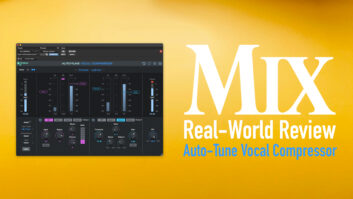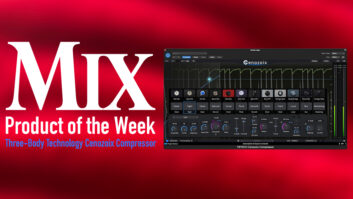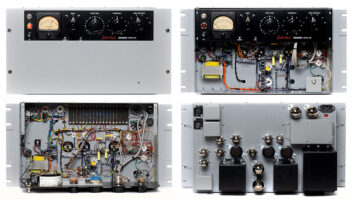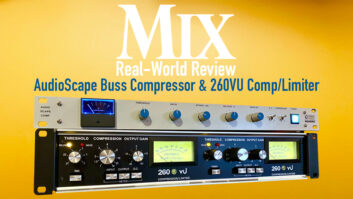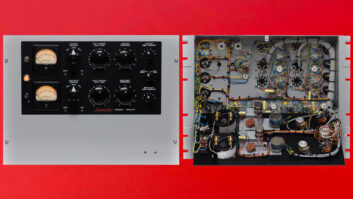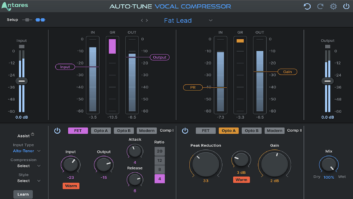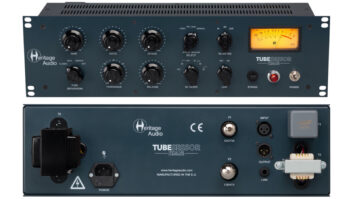

In audio circles, Austin, Texas, is known for Austin City Limits, SXSW, Robert Rodriguez, Rupert Neve Designs and now Burgin McDaniel, a new startup with a great first product called Komit ($995). Don’t let the faux-Soviet-styling distract you from Komit’s main intention: to provide quality gain control ranging from “Is it on?” to a flat-line distorted crush reminiscent of John Lennon’s vocal on “Revolution.” The vertical unit fits into any API 500 Series rack or an old-style API console’s EQ slot. Burgin McDaniel also offers Treehouse, a slick-looking wooden enclosure housing two units and a Link button to use the pair in any stereo application. I used a set both in and out of the box, and they worked well in both situations.
BOTTOMS UP
The Komit’s solid construction features good switches, rotary pots and a thick faceplate. At first, it took me a second to figure out that Komit’s signal flows from the bottom to the top. The hard-bypass switch starts it off, and above that is a cryptic-looking ratio knob. The ratio settings are depicted around the knob as a series of circle images; the first one is perfectly round (1:1), and then each successive circle becomes ever flatter and more compressed as you turn the knob clockwise. As the ratio increases, the output level remains constant, provided that the gain knob is set to unity. This level control allows you to add quite a lot of gain over unity and to feed (or over-feed) the limiter stage and output, providing a nice way to add some overdriven color to the signal. The limiter is a detented switch with 11 ceiling settings from +21 dBu down to -10, plus an off position. Envelope control comes in a three-position toggle offering quick attack/release (left), program-related and automatic (middle position) or slow attack/release (right).
At the top is the most useless part of Komit: the meter. One of my units had a faulty meter and I never missed it once: It provides more confidence than clarification. This unit is made for your ears. If you know what you’re looking for, or if you’re up for some fun sonic exploration, Komit can take you there and beyond.
FUN FACTOR
I ran the Komits on a variety of tracks with excellent results. My first application was on a pair of omni mics placed high and behind a drum kit. The Komits were set to a 2 o’clock ratio, and about the same on the limiter with a bit of gain added to the output for some mild distortion. Although the Komit provided a lot of compression, the kit’s bottom end — at 100 Hz and below — was still quite full. When A/B’d with a pair of SSL 4000 Series channel compressors set to a comparable amount of compression, the difference was stark. The console’s units, while sounding great, did not nearly have the bottom-end presence that the Komits left behind after they did their work.
Komit worked very well on both acoustic and electric guitars. By playing with the three-way attack/release control, I was able to nail down a very dynamic acoustic strummed guitar part without any pumping. On electric guitars, it was just the ticket to bring a pair of full-bodied, heel-of-the-palm-muted rhythm guitar tracks up in the mix while maintaining the full body of the parts at the low end. I also added some nice extra “hair” (aka, distortion) to these parts by adding some gain via the output gain knob.
Next, I put a Komit on a snare drum. Using the three-way attack/release toggle switch, I changed the envelope of the sound quite a bit. When I set the switch to fast, the snare was flattened in the mix. My favorite setting was auto; it lets the attack into the mix, which was then quickly clamped down, giving it a tasteful, slightly gated sound that brought out the snares. Even the slow attack/release setting worked well, giving me a third option that I could audition with the rest of the kit.
I was impressed with how Komit sounded on bass. It brought out the instrument in the mix while leaving its bottom intact. I was also surprised at how easy it was to dial in some great sounds. With just a few clicks of the limiter, attack switch and gain knob, I had a nice variety of sounds with which to play. I was equally pleased when I inserted Komit on a vocal track. I was able to rein in the dynamics using a combination of medium compression and the limiter as a safety net, all with a slow attack/release — perfect.
No matter what I used it on, I couldn’t help but crank up the gain, even with the compressor at 1:1, just to hear how the distortion bent the sound. Taking it to the limit(er) in this fashion was delicious.
COMMIT TO KOMIT
I usually start any review wearing my skeptic’s hat, but Komit quickly won me over. From the first time I put it across a track, my “wow” button was pushed: I loved being able to A/B my input without the level changing. Out of the box, I accidentally had the pair of limiters set to -10 threshold, thinking the unit was off, and put Komit across a pair of drum room mics. While unusable in this particular track, the effect of crushing the kit flat to distortion was still beautiful and opened my mind to how far you can take this unit and still have it sound interesting. From there, I started having fun with Komit, playing with its presets, using compression with and without limiting, and vice versa — and all very quickly.
Keep your eye on Burgin McDaniel and check out Komit: It runs from tasteful to terrible, all with a great vibe.
Burgin McDaniel, 512/667-8573, www.burginmcdaniel.com.
Kevin Becka is Mix’s technical editor.

